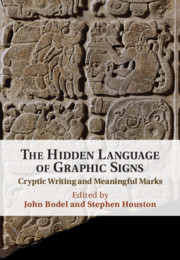Book contents
- The Hidden Language of Graphic Signs
- The Hidden Language of Graphic Signs
- Copyright page
- Contents
- Contributors
- Abbreviations
- Introduction
- Part I Hidden Writing
- One Buried and Camouflaged Writing in Early China
- Two Dazzled and Absorbed
- Three Impossible Unities
- Four Inscribe and De-scribe/Cipher and De-cipher
- Five Script, Pseudoscript, and Pseudo-pseudoscript in the Work of Filippo Lippi
- Six Numerals as Letters
- Part II Legible Signs
- References
- Index
Four - Inscribe and De-scribe/Cipher and De-cipher
A Pious Phrase in Medieval Byzantium and Islam
from Part I - Hidden Writing
Published online by Cambridge University Press: 23 August 2021
- The Hidden Language of Graphic Signs
- The Hidden Language of Graphic Signs
- Copyright page
- Contents
- Contributors
- Abbreviations
- Introduction
- Part I Hidden Writing
- One Buried and Camouflaged Writing in Early China
- Two Dazzled and Absorbed
- Three Impossible Unities
- Four Inscribe and De-scribe/Cipher and De-cipher
- Five Script, Pseudoscript, and Pseudo-pseudoscript in the Work of Filippo Lippi
- Six Numerals as Letters
- Part II Legible Signs
- References
- Index
Summary
Over a span of a millennium or more, Maya scribes and sculptors in the Maya lowlands used a writing system notable for its formal complexity and close links to imagery. At times, in so-called full-figure writing, glyphic elaboration erupts into a welter of massed bodies, imparting a misleading impression of narrative pictures. Wit and fun seem to abound, along with hints of an exuberant, scribal personality behind certain inscriptions. The stress on physicality ‒ things with interiors, exteriors, and defining edges in between ‒ is thoroughgoing. Efficiencies of graphic presentation lead logically to a design choice, whether to show a full thing-in-the-world, or to abbreviate that display by exhibiting a recognizable feature. As a deliberate category error ‒ is it picture, is it text? ‒ full-figure signs heighten the pleasure of being puzzled. They build in part on the cognitive frissons of the Stroop Effect, in which one set of information collides with another. The pictorial interaction of such signs ranges along one of two extremes: sociable contact that is decorous, restrained, respectful, and an indecorous, emotive striving that might lead to uncertain outcomes. In the most extreme cases, Maya writing oscillates between controllability and a bare containment of feral will in the glyphs.
Keywords
- Type
- Chapter
- Information
- The Hidden Language of Graphic SignsCryptic Writing and Meaningful Marks, pp. 80 - 99Publisher: Cambridge University PressPrint publication year: 2021

